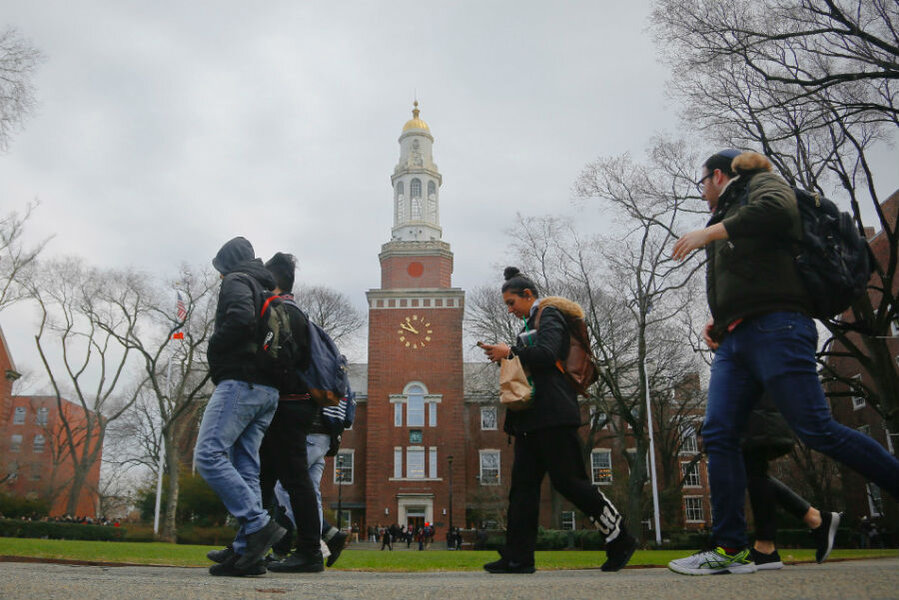A first: New York will offer free tuition at all four-year state colleges for qualifying families
Loading...
On Sunday, the New York State Senate passed a budget that includes a $163-million initiative to offer free tuition at public colleges and universities to students with an annual family income of $125,000 or less. The new program represents a first in the United States: Never before has a state offered free tuition to any four-year state university or community college, including students from many families whose income levels would be considered middle class.
The Excelsior scholarship, which was first proposed by New York Governor Andrew Cuomo in January, was included in the state's $153-billion state budget proposal. The program will be phased in over the next few years, but families earning $100,000 or less will be able to take advantage of the scholarship beginning in the fall.
The new scholarship will break new ground in the US, yet it is only the latest proposal aimed at making college more affordable. Across the country, legislators and education officials have begun reevaluating the rising cost of higher education and the increasing necessity of collegiate training in many fields of employment. A number of cities and states have programs helping students with tuition at community colleges, while Tennessee, Oregon, and Minnesota offer tuition-free community college.
For Sara Goldrick-Rab, a professor and education expert at Temple University's College of Education in Philadelphia, the New York program represents an important and necessary step to help lower-income students in a changing US economy.
"Most Americans attend public higher education, and the price in that sector has risen substantially over time as states have decided to allocate less support on a per-student basis, leaving each individual student to cover more of the bill for their education," Dr. Goldrick-Rab tells The Christian Science Monitor in an email. "It's quite straightforward – the fraction of the cost of a college education covered by the state goes down, and the fraction covered by a student goes up."
The high cost of tuition has become an increasingly important issue for many Americans, as rising administrative costs and dwindling financial aid availability continue to inflate the price of a college education for students across the country. A Gallup poll from February 2016 found that 35 percent of Millennials now carry student loan debt, along with a quarter of all Generation Xers. This information can lead many prospective students to question whether going to college is worth the enormous cost, even for those whose families belong to income brackets that have traditionally been able to afford higher education.
"The existing aid system offers insufficient funding to lower-income students, leaving them short, while also excluding the many lower-income students who can't afford to trust a system that says 'Trust us, college will be affordable,' without stating the price," Goldrick-Rab says. "Moreover, a growing number of middle-class students are also being priced out as their family incomes have stagnated or even declined while public sector prices rise. They are too rich to qualify for need-based aid and too poor to afford college without it."
The solution may seem simple enough – just enter the workforce straight out of high school. But many point to statistics that indicate that college grads earn far more than their counterparts, with more employers than ever before coming to see a Bachelor's degree, rather than a GED, as a minimum education qualification for many jobs.
"College is today what high school was 50 years ago," Gov. Andrew Cuomo said on a radio interview Sunday on AM 970 in New York City, according to the Associated Press. "If you're a young person who wants success and a career, a college education is necessary."
Governor Cuomo's new scholarship could help up to 940,000 families qualify for the new higher-education benchmark by the time the program is fully implemented in 2019, but there are a few qualifications. First, students must agree to live and work in New York for the same number of years after graduation as they received the scholarship, a condition that could prove troublesome for some students. Second, the scholarship does not cover room, board, and other expenses that could prove prohibitive for many families.
With all this in mind, says William Sanders, a professor of economics at DePaul University in Chicago, it may be worth considering alternatives to college altogether – not just as prospective students, but as a society.
"On the average, students with a college education do better in the job market than students with less education," Dr. Sanders tells the Monitor via email. "However, college is not for everyone. For this reason, we should pay more attention for training, apprenticeships, etc., outside of college."
Still, the disparity between the growing necessity of intensive post-high school training for many jobs and the high cost of receiving that training is a crisis that needs to be dealt with, says Goldrick-Rab. States such as Tennessee and Oregon have already begun to explore programs that provide free community college to residents in order to keep less-educated citizens from being left behind.
"The goal should be to lower the price charged, not the cost (which is the money required to deliver a quality education)," says Goldrick-Rab. "We need to restore state support in any manner possible, ideally coupled with federal support, and provide all students with a clear, accessible, high-quality opportunity for education in the public sector."
This article contains material from the Associated Press.








